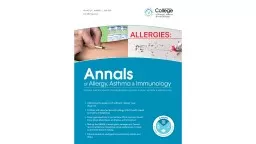

Sravani Penumarty MD LinhAn Tuong MD Reena Khianey MD John Oppenheimer MD Ann Allergy Asthma Immunol June 20201246546547 Prearthroplasty Algorithm for the Evaluation of Metal Allergy in Patients with a History of Metal Hypersensitivity to Previous Orthopedic Implants ID: 908522
Download Presentation The PPT/PDF document "Metal Hypersensitivity in Total Joint Ar..." is the property of its rightful owner. Permission is granted to download and print the materials on this web site for personal, non-commercial use only, and to display it on your personal computer provided you do not modify the materials and that you retain all copyright notices contained in the materials. By downloading content from our website, you accept the terms of this agreement.
Slide1
Slide2Metal Hypersensitivity in Total Joint Arthroplasties
Sravani Penumarty, MD
Linh-An Tuong, MD
Reena Khianey, MD
John Oppenheimer, MD
Ann Allergy Asthma Immunol. June 2020;124(6):546-547
Slide3Prearthroplasty
Algorithm for the Evaluation of Metal Allergy in Patients with a History of Metal Hypersensitivity to Previous Orthopedic Implants
Penumarty S, et al. Ann Allergy Asthma Immunol. June 2020;124(6):546-547
Slide4Addressing the Epidemic of Antibiotic “Allergy”
Over-Diagnosis
Eric Macy, MD, MS
Ann Allergy Asthma Immunol.
June 2020;124(6):550-557
Slide5Three Important Ways to Avoid Inappropriate Antibiotic Use
Macy E. Ann Allergy Asthma Immunol. June 2020;124(6):550-557
Slide6Elements in the Antibiotic-Associated Adverse Reaction History Suggestive of Immunologically Mediated Hypersensitivity Where Testing is Indicated
Macy E. Ann Allergy Asthma Immunol. June 2020;124(6):550-557
Slide7Children with Reported Penicillin Allergy
David Vyles, DO, MS
James W. Antoon, MD, PhD
Allison Norton, MD
Cosby A. Stone Jr., MD, MPHJason Trubiano, MBBS, PhD
Alexandra Radowicz, BSElizabeth J. Phillips, MD, FIDSA, FAAAAIAnn Allergy Asthma Immunol.
June 2020;124(6):558-565
Slide8Children with Reported Penicillin Allergy
Key Messages
Vyles D, et al. Ann Allergy Asthma Immunol. June 2020;124(6):558-565
Most allergies in pediatric patients are self-reported and often inconsistent with true allergy. Most of these supposed allergic reactions are attributed to β-lactam antibiotics.
Traditional penicillin allergy testing has involved a 3-tier approach; however, mounting evidence indicates that a direct oral challenge in children with low-risk allergy symptoms may be the optimal approach to delabel a child with reported β-lactam allergy.Children with reported penicillin or drug allergies are often found to have an increase in alternative prescriptions for their bacterial illness.Prescription costs are 30% to 40% higher in patients with suspected penicillin allergy.With the evidence indicating the safety of delabeling
and the accumulating evidence for the negative economic, individual, and public health burden of a penicillin allergy diagnosis, there is a need to establish strategies and programs to develop feasible, scalable, and effective approaches.
Slide9Antibiotic Pathway in Children with Penicillin Allergy
Vyles D, et al. Ann Allergy Asthma Immunol. June 2020;124(6):558-565
Slide10Risk-Stratified Pathway for Penicillin Allergy Evaluation
Vyles D, et al. Ann Allergy Asthma Immunol. June 2020;124(6):558-565
Slide11Drug Hypersensitivity in the Fast Lane:
What Clinicians Should Know About Phenotypes, Endotypes, and Biomarkers
Baruch D. Jakubovic, MD
Leticia de las Vecillas, MD
Teodorikez Wilfox Jimenez-Rodriguez, MDSoledad Sanchez-Sanchez, MD
Mariana Castells, MD, PhDAnn Allergy Asthma Immunol. June 2020;124(6):566-572
Slide12Drug Hypersensitivity in the Fast Lane
Key Messages
Jakubovic BD, et al. Ann Allergy Asthma Immunol. June 2020;124(6):566-572
Drug hypersensitivity represents a small area of focus within allergy & immunology with broad clinical impact.
Categorization of drug hypersensitivity can be amplified with current evidence-based studies of reactions to chemotherapy and monoclonal antibodies.A novel model of drug hypersensitivity classification involving phenotypes, endotypes, and biomarkers is appropriate for precision medicine.Drug desensitization is an evidence-based and robust therapeutic procedure for use in selected patients with immediate hypersensitivity reactions.
Slide13A Contemporary Model for Drug Hypersensitivity: Viewing Reactions through the Prism of Phenotypes, Endotypes, and Biomarkers
Jakubovic BD, et al. Ann Allergy Asthma Immunol. June 2020;124(6):566-572
Slide14Classification of Phenotype-Endotype Relationships in Immediate Hypersensitivity Reactions
Jakubovic BD, et al. Ann Allergy Asthma Immunol. June 2020;124(6):566-572
Slide15Procedural Considerations Regarding Rapid Drug Desensitization
Jakubovic BD, et al. Ann Allergy Asthma Immunol. June 2020;124(6):566-572
Slide16Clinical Aspects of Sublingual Immunotherapy
Tablets and Drops
Mike Tankersley, MD, MBA
Joseph K. Han, MD
Hendrik Nolte, MD, PhD
Ann Allergy Asthma Immunol. June 2020;124(6):573-582
Slide17Clinical Aspects of Sublingual Immunotherapy
Tablets and Drops Key Messages
Tankersley M, et al. Ann Allergy Asthma Immunol. June 2020;124(6):573-582
Storage requirements and stability differ between sublingual immunotherapy (SLIT) via tablets (SLIT-T) vs liquid drops (SLIT-D).
Whether there are any differences in mechanism of action between SLIT-T and SLIT-D is currently unknown.Optimal doses for SLIT-T have been established in randomized, double-blind, clinical trials, whereas there is no standard dosing or dosing formula for SLIT-D in the United States. Rigorous placebo-controlled, double-blind trials are needed to determine the effective dose ranges of SLIT-D in North America.The efficacy of SLIT for allergic rhinoconjunctivitis and asthma has been demonstrated in multiple meta-analyses, but most meta-analyses do not distinguish between trials of SLIT-T and SLIT-D. No head-to-head trials of SLIT-T and SLIT-D have been conducted.The safety profiles of SLIT-T and SLIT-D appear similar, and both formulations are safer than subcutaneous immunotherapy.
Class effects between SLIT-T and SLIT-D cannot be assumed, and individual products need to be evaluated in well-controlled clinical trials to establish dosing, efficacy, and safety.
Slide18Fate of the Allergen After Sublingual Administration
Tankersley M, et al. Ann Allergy Asthma Immunol. June 2020;124(6):573-582
Slide19Potency of Cumulative Monthly Maintenance Dose of Sublingual Immunotherapy Via Liquid Drops (SLIT-D) Prescribed by US Allergists as Reported in a 2018 Survey
Tankersley M, et al. Ann Allergy Asthma Immunol. June 2020;124(6):573-582